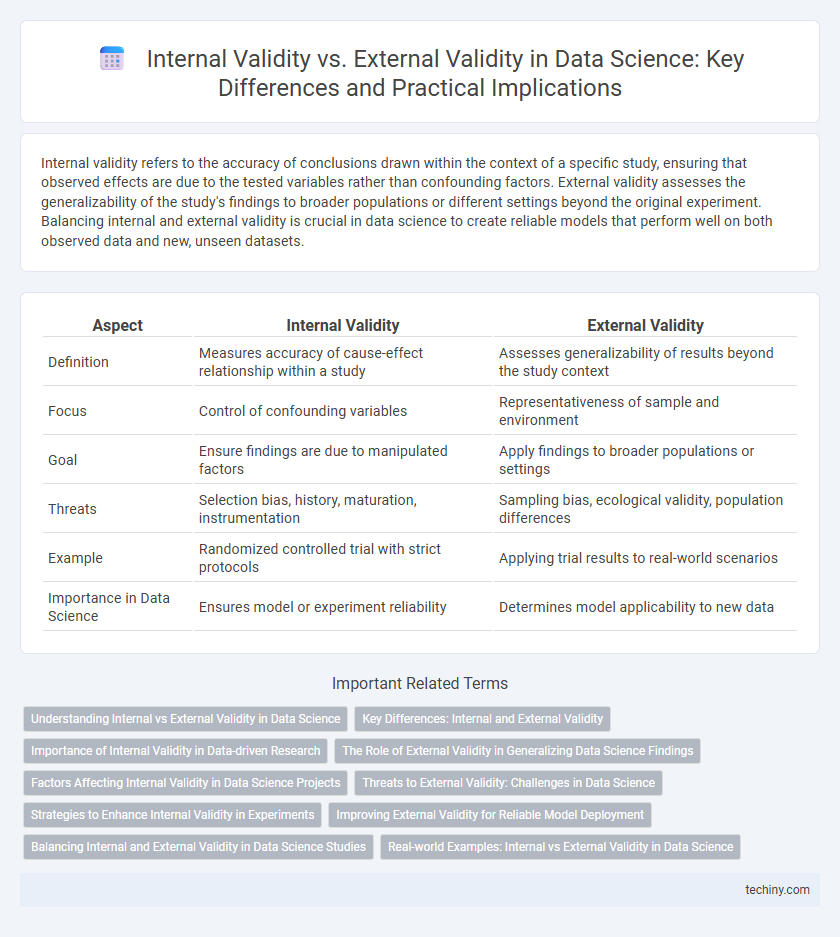Internal validity refers to the accuracy of conclusions drawn within the context of a specific study, ensuring that observed effects are due to the tested variables rather than confounding factors. External validity assesses the generalizability of the study's findings to broader populations or different settings beyond the original experiment. Balancing internal and external validity is crucial in data science to create reliable models that perform well on both observed data and new, unseen datasets.
Table of Comparison
| Aspect | Internal Validity | External Validity |
|---|---|---|
| Definition | Measures accuracy of cause-effect relationship within a study | Assesses generalizability of results beyond the study context |
| Focus | Control of confounding variables | Representativeness of sample and environment |
| Goal | Ensure findings are due to manipulated factors | Apply findings to broader populations or settings |
| Threats | Selection bias, history, maturation, instrumentation | Sampling bias, ecological validity, population differences |
| Example | Randomized controlled trial with strict protocols | Applying trial results to real-world scenarios |
| Importance in Data Science | Ensures model or experiment reliability | Determines model applicability to new data |
Understanding Internal vs External Validity in Data Science
Internal validity in data science ensures that the observed results accurately reflect the true causal relationship within the study sample, minimizing biases and confounding variables. External validity refers to the generalizability of these findings to broader populations or different settings, enabling reliable application beyond the initial study context. Balancing internal and external validity is crucial for developing robust predictive models and drawing trustworthy conclusions from experimental data.
Key Differences: Internal and External Validity
Internal validity refers to the accuracy with which a study establishes a causal relationship between variables within its experimental design, emphasizing control over confounding factors and bias. External validity assesses the generalizability of the study's findings to broader populations, settings, or times beyond the experimental conditions. The key difference lies in internal validity's focus on the credibility of cause-effect conclusions internally, while external validity evaluates the applicability of those conclusions in real-world contexts.
Importance of Internal Validity in Data-driven Research
Internal validity ensures the accuracy of causal inferences within a data-driven study by controlling confounding variables and minimizing biases. High internal validity is critical for establishing reliable relationships between independent and dependent variables, which strengthens the credibility of model predictions and experimental results. Without internal validity, data scientists risk drawing incorrect conclusions that compromise the overall integrity and applicability of their research findings.
The Role of External Validity in Generalizing Data Science Findings
External validity determines the extent to which data science findings can be generalized beyond the original study conditions to real-world applications, ensuring the results apply across different populations, settings, and times. High external validity is crucial for deploying predictive models and machine learning algorithms in diverse environments, as it confirms that insights are not limited to specific datasets or experimental designs. Emphasizing external validity enhances the practical impact of data-driven solutions by validating their robustness and adaptability across varied use cases.
Factors Affecting Internal Validity in Data Science Projects
Factors affecting internal validity in data science projects include selection biases, measurement errors, and confounding variables that can distort causal relationships within datasets. Inconsistent data collection methods and lack of controlling for extraneous variables weaken the reliability of model inferences. Ensuring rigorous experimental design and robust data preprocessing enhances internal validity by minimizing threats that compromise the accuracy of predictive analytics.
Threats to External Validity: Challenges in Data Science
Threats to external validity in data science arise when models trained on specific datasets fail to generalize across different populations or environments, limiting their applicability. Variations in data distribution, sampling bias, and contextual differences pose significant challenges to ensuring model robustness in real-world scenarios. Addressing these threats requires rigorous cross-validation techniques and domain adaptation strategies to enhance the generalizability of predictive analytics.
Strategies to Enhance Internal Validity in Experiments
Strategies to enhance internal validity in data science experiments include randomization, which minimizes selection bias by evenly distributing confounding variables across experimental groups. Implementing control groups and blinding procedures reduces the influence of placebo effects and observer bias, ensuring more accurate causal inferences. Careful measurement and standardized protocols further strengthen internal validity by maintaining consistency and precision in data collection.
Improving External Validity for Reliable Model Deployment
Enhancing external validity in data science involves using diverse, representative datasets that capture real-world variability to ensure models generalize well beyond training data. Techniques like cross-validation on external datasets, domain adaptation, and rigorous out-of-sample testing improve the robustness and reliability of predictive models. Prioritizing external validity reduces risks of model overfitting and ensures consistent performance across different populations, making deployment more dependable.
Balancing Internal and External Validity in Data Science Studies
Balancing internal validity and external validity in data science studies requires rigorous experimental controls to ensure reliable causal inference while maintaining generalizability to diverse populations. Employing techniques such as randomized controlled trials enhances internal validity, whereas using representative samples and real-world datasets improves external validity. Striking an optimal balance allows data scientists to draw meaningful conclusions that are both accurate and applicable across varied contexts.
Real-world Examples: Internal vs External Validity in Data Science
Internal validity in data science ensures that the outcomes of a model or experiment accurately represent causal relationships within the dataset, as demonstrated by controlled A/B testing in digital marketing campaigns. External validity evaluates the generalizability of these findings to other contexts, such as applying a consumer behavior model developed from one region's e-commerce data to a different demographic or geographic market. For example, a predictive maintenance algorithm trained on manufacturing sensor data from one plant must be validated externally before deployment across diverse industrial settings.
Internal Validity vs External Validity Infographic

 techiny.com
techiny.com